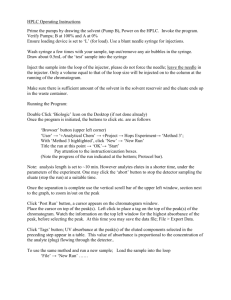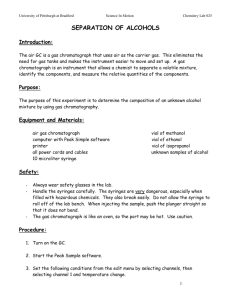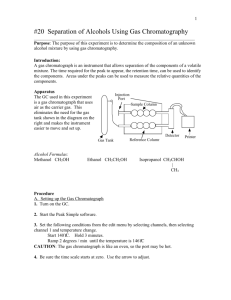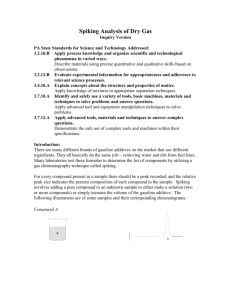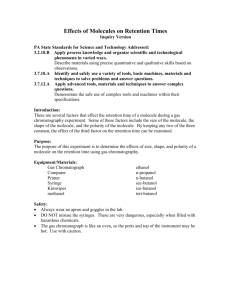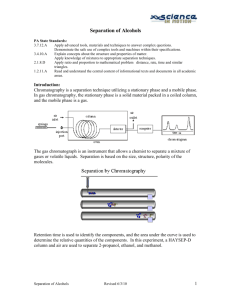Introduction
advertisement
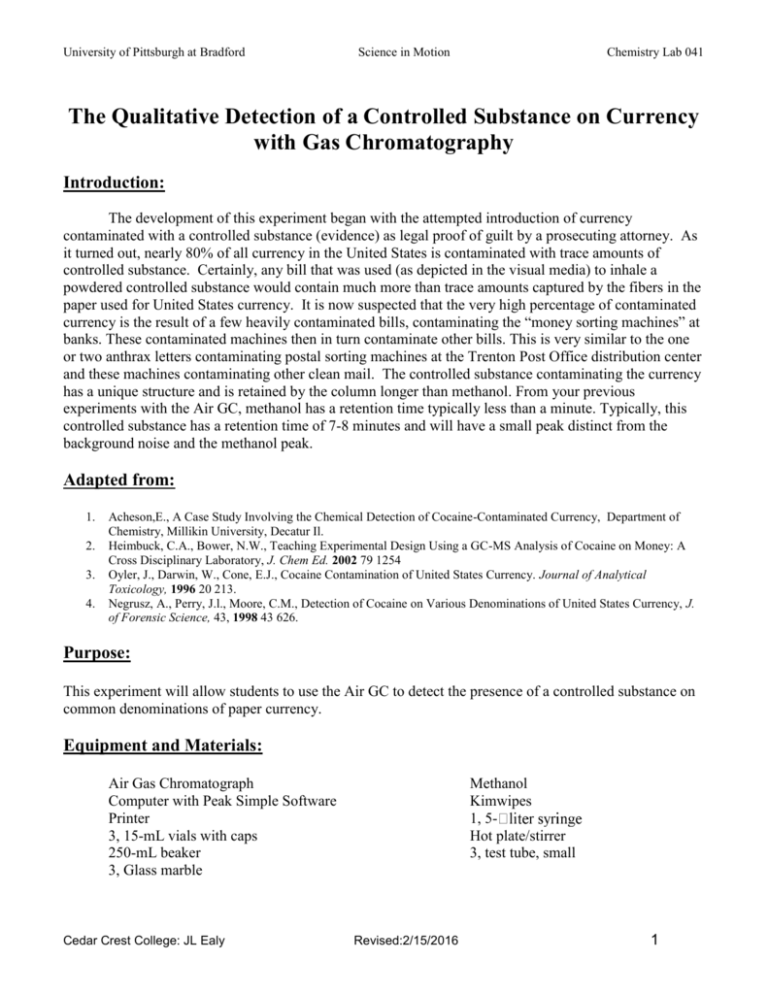
University of Pittsburgh at Bradford Science in Motion Chemistry Lab 041 The Qualitative Detection of a Controlled Substance on Currency with Gas Chromatography Introduction: The development of this experiment began with the attempted introduction of currency contaminated with a controlled substance (evidence) as legal proof of guilt by a prosecuting attorney. As it turned out, nearly 80% of all currency in the United States is contaminated with trace amounts of controlled substance. Certainly, any bill that was used (as depicted in the visual media) to inhale a powdered controlled substance would contain much more than trace amounts captured by the fibers in the paper used for United States currency. It is now suspected that the very high percentage of contaminated currency is the result of a few heavily contaminated bills, contaminating the “money sorting machines” at banks. These contaminated machines then in turn contaminate other bills. This is very similar to the one or two anthrax letters contaminating postal sorting machines at the Trenton Post Office distribution center and these machines contaminating other clean mail. The controlled substance contaminating the currency has a unique structure and is retained by the column longer than methanol. From your previous experiments with the Air GC, methanol has a retention time typically less than a minute. Typically, this controlled substance has a retention time of 7-8 minutes and will have a small peak distinct from the background noise and the methanol peak. Adapted from: 1. 2. 3. 4. Acheson,E., A Case Study Involving the Chemical Detection of Cocaine-Contaminated Currency, Department of Chemistry, Millikin University, Decatur Il. Heimbuck, C.A., Bower, N.W., Teaching Experimental Design Using a GC-MS Analysis of Cocaine on Money: A Cross Disciplinary Laboratory, J. Chem Ed. 2002 79 1254 Oyler, J., Darwin, W., Cone, E.J., Cocaine Contamination of United States Currency. Journal of Analytical Toxicology, 1996 20 213. Negrusz, A., Perry, J.l., Moore, C.M., Detection of Cocaine on Various Denominations of United States Currency, J. of Forensic Science, 43, 1998 43 626. Purpose: This experiment will allow students to use the Air GC to detect the presence of a controlled substance on common denominations of paper currency. Equipment and Materials: Air Gas Chromatograph Computer with Peak Simple Software Printer 3, 15-mL vials with caps 250-mL beaker 3, Glass marble Cedar Crest College: JL Ealy Methanol Kimwipes 1, 5Hot plate/stirrer 3, test tube, small Revised:2/15/2016 1 Safety: - - Refer to MSDS. Always wear safety glasses in the lab and observe safe and prudent laboratory practices. Handle the syringes carefully. The syringes are very dangerous, especially when filled with hazardous chemicals. They also break easily. Do not allow the syringe to roll off of the lab bench. When injecting the sample, push the plunger straight so that it does not bend. The gas chromatograph is similar to an oven, so the port may be hot. Use caution. Most alcohols are irritating and flammable. Wipe up any spills with paper towels immediately. Procedure: To start the GC and Peak Simple Software 1. Turn on the GC. Click on the Peak Simple Icon to start the Peak Simple software. A blank chromatogram screen will appear, maximize the screen. 2. Click on Edit, then channels to display the control box. Be sure that a “check” appears in the three boxes on the left side of Channel 1. 3. Click on Details, make sure the end time is 15 minutes, then click on OK. 4. Click on the Temperature Box. Click clear if not set correctly. Then click on Add. Set Initial temp by typing 140oC. Tab down to Until Temperature is and type in 140oC. Click on OK. A Temperature Control Channel 1 box should appear with the correct settings. If not, click on change and enter correct settings. Alternately, you may also “load” the file Iso Temp @140oC, then click on OK. 5. Click on Events Box. Click clear if not set correctly. Then click on Add. Click on the Zero button and then make the Event Time = 0.005. Click on OK to close the Event Details box. Then click OK to close the Channel 1 Events box. Click OK on the Channels box and you will return to the main screen and you will see “STAND BY” followed by a milli-volt reading from the detector. Alternately, you may also Load the file Zero, then click on OK. Procedure: For Experiment 1. Place 2 or 3 one dollar bills in a vial. Add 2 mL of methanol. Shake for 2+ minutes. The longer the better. 2. Carefully decant the methanol into a small test tube. Place glass marble on top of test tube. 3. Repeat with two more set of bills. ($5 and $10 or $20) 4. Place all three test tubes with marble tops in the water bath at 50-60oC. Heat until less than 0.25 mL remains in each test tube. This must be carried out in a hood. 5. Cedar Crest College: JL Ealy Revised:2/15/2016 2 6. The syringe needs to be cleaned with methanol. Follow the following procedures: With the plunger fully depressed, place the needle into the alcohol. Slowly draw up the plunger to obtain a sample of the pure solvent in the syringe. Remove the syringe from the methanol. Discharge the methanol into a waste container. Repeat twice more. 7. Place the syringe needle into the sample test tube, and obtain 3.0 needle with a Kimwipe. 8. Insert the needle carefully into the injection port of the GC until the needle stops. 9. Inject the sample, and start the data collection by simultaneously depressing the syringe plunger and pressing the space bar on the computer at the same time. Be sure to HOLD the plunger in, to prevent the air pressure in the GC from pushing the plunger out at someone. Remove the syringe at the 0.10 minutes on the timer. 10. When the sample peak returns to the baseline, the run may be stopped by pressing the End button on the computer. For the unknowns, make sure the run is long enough for all of the chemicals to have peaked. 11. After the peak is obtained, record the data or print the graph as instructed. 12. Repeat steps 1 - 11 for each denomination. Procedure: for Printing Chromatogram with PeakSimple: 1. Click on File, and then on Print. Click on Print then place a check in the Print Header box by clicking on the box if needed. Then click on the Format bar. 2. In the Header Format menu, place a check in each of the following boxes by clicking on the box. Remove all other checks by clicking on the boxes. Place checks in the following: Lab name, Analysis date, Temp prog (in front of list), Events (in front of list), Data File, Sample, and Comments. In the space after Lab name: type the name of your school, and in the space after Sample: type your initials and sample info. Then click OK. 3. Click on the box in front of Print chromatogram to place a check in that box, if needed. Then click on the Format bar. In the Chromatogram format menu, place checks in the boxes in from of Screen limits and the Draw retention window. In the Start space, type 0.00 (if necessary) and the appropriate stop time in the Stop space. Click on OK. 4. Click on the box in front of the Print report to place a check in that box if necessary. The click on the Format bar. Be sure the following items are in the Selected box: Retention, Area, Temp, Analysis date, Events, Area%, Sample, Units and <end> If any of the above are missing, click on that item in the Available box and click on the >> bar to place the item in the Selected box. Remove all items other than those mentioned above from the Selected box by clicking on the item and then clicking on the << bar to place it back in the Available box. Click on OK. The click on the Print bar. Cedar Crest College: JL Ealy Revised:2/15/2016 3 Calculations and Analysis: 1. Compare the chromatograms of the samples with the chromatogram provided of the controlled substance dissolved in the methanol. Questions: 1. Were the peaks with a retention time of 7 – 8 minutes distinct from the background noise of the instrument? Explain. 2. Was there a distinct peak around 7- 8 minutes for each denomination. 3. If the peaks around 7 – 8 minutes were distinct from the background noise, can you draw a conclusion about the presence of the controlled substance on the currency tested. Differences in denominations? Cedar Crest College: JL Ealy Revised:2/15/2016 4
